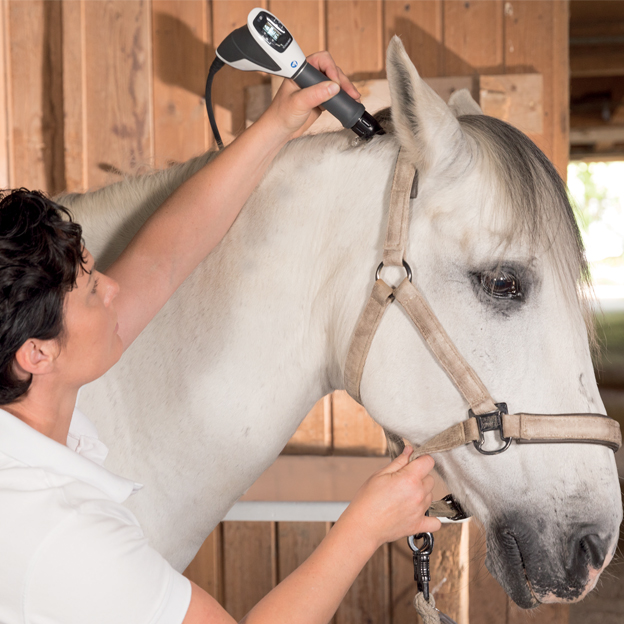Why Equine Therapy is Coming To Be a Preferred Choice for Emotional Health
Why Equine Therapy is Coming To Be a Preferred Choice for Emotional Health
Blog Article
How Laser Therapy in Horse Treatment Is Transforming Vet Care for Horses
Laser therapy has actually arised as a transformative approach in equine vet care, giving a non-invasive service that expedites recovery and enhances overall health. The portability and versatility of laser therapy devices better emphasize their expanding necessity among veterinarians.
Recognizing Laser Treatment

The innovation behind laser therapy is based in the concept of photochemistry, where photons are taken in by chromophores within cells, resulting in raised ATP production and inflection of reactive oxygen varieties (Equine Therapy). This, subsequently, promotes mobile spreading, reduces swelling, and accelerates recovery. Veterinary experts utilize various sorts of lasers, including low-level lasers (LLLT) and high-power Class IV lasers, depending on the details healing goals and the nature of the equine problem being dealt with
Different laser wavelengths and power settings are meticulously chosen to target various tissue depths and attain preferred medical results. Safety and security methods are vital, as inappropriate use can lead to thermal damages or suboptimal therapeutic impacts. Thus, a thorough understanding of laser therapy's mechanisms and applications is vital for its reliable implementation in equine veterinary method.
Advantages for Equine Wellness
The myriad advantages of laser therapy for equine health incorporate boosted healing, discomfort reduction, and improved mobility. This advanced therapy technique leverages particular wavelengths of light to pass through cells, boosting cellular function and promoting quick tissue repair work. The non-invasive nature of laser treatment guarantees very little stress and discomfort for the steed, promoting a smoother recuperation procedure.
Enhanced recovery is one of the primary benefits, as laser treatment speeds up mobile regrowth and collagen synthesis. Discomfort reduction is achieved through the anti-inflammatory effects of laser treatment, which reduces swelling and reduces the manufacturing of pain-inducing chemicals.
Enhanced movement is another crucial benefit, particularly for efficiency and working equines. By minimizing swelling and discomfort, and improving cells repair, laser treatment assists in restoring joint feature and muscular tissue adaptability. The collective effect of these benefits is not only a quicker return to regular task yet additionally a total enhancement in the horse's high quality of life. Thus, laser therapy stands as a transformative device in modern equine vet care.
Typical Problems Treated
Laser therapy has actually arised as a functional treatment alternative for a range of usual equine conditions. Amongst these, musculoskeletal injuries are specifically responsive to laser therapy. Equine Therapy. Soft tissue injuries, such as tendonitis and tendon pressures, gain from the anti-inflammatory and analgesic results of laser treatments, which increase recovery and reduce discomfort. In addition, laser therapy is reliable for conditions like osteo arthritis, where it assists mitigate joint inflammation and promote tissue repair service.
Wound management is one more area where laser treatment has revealed substantial guarantee. Chronic injuries or slow-healing abscess can be particularly difficult in equines, yet laser treatment boosts mobile regeneration and boosts blood flow, thus speeding up the recovery procedure. Laser therapies have been efficiently employed in taking care of hoof problems such as laminitis and abscesses, alleviating discomfort and promoting quicker recuperation.

Innovation Behind Laser Therapy
Beyond the myriad problems treatable with laser therapy, the technology itself values better evaluation. At the heart of laser treatment is the usage of specific wavelengths of light to permeate tissues and evoke organic feedbacks. These wavelengths, normally varying from 600 to 1000 nanometers, are precisely soaked up by chromophores in the skin, muscle mass, and other cells, instigating a waterfall of cellular events.
Laser devices used in veterinary medication often utilize low-level laser treatment (LLLT) or cool laser treatment. Unlike high-powered surgical lasers, these gadgets run at reduced energy levels, maximizing healing advantages while decreasing thermal damages. The power from the laser light promotes adenosine triphosphate (ATP) manufacturing, improves cellular metabolic rate, and speeds up cells repair processes.

Success Stories and Study

Showcasing the concrete advantages of laser therapy, various success stories and case research studies illuminate its transformative effect on equine health and wellness. One such situation entails a pedigreed racehorse suffering from persistent tendonitis. Standard treatments yielded very little renovation, however after incorporating laser therapy right into the regimen, the horse displayed substantial decreases in inflammation and discomfort within weeks, eventually going back to affordable racing.
Another engaging instance features a dressage equine detected with serious back discomfort, limiting its efficiency. A vet team employed low-level laser treatment (LLLT) to target the swollen locations, leading to significant renovation in adaptability and a noteworthy decrease in pain. Over several sessions, the steed reclaimed its peak kind, showcasing the efficiency of laser therapy in addressing musculoskeletal problems.
In addition, a research study conducted at a leading equine facility analyzed 50 equines with different soft tissue injuries treated with laser treatment. The results stood out: 85% of the steeds demonstrated accelerated healing times and enhanced flexibility. These instances highlight the versatility and efficiency of laser treatment in equine medication, offering a non-invasive, scientifically-backed technique to boosting healing and efficiency in horses.
Verdict
Laser therapy is revolutionizing equine vet treatment by offering a non-invasive therapy that speeds up healing, decreases swelling, and eases discomfort. With its efficiency in treating a series of conditions, from bone and joint injuries to chronic disorders like osteo arthritis, this innovation dramatically improves equine health and wellness and mobility. The portability and my link versatility of laser therapy further underscore its transformative influence on veterinary methods, solidifying its duty as a vital tool in contemporary equine health care.
Report this page